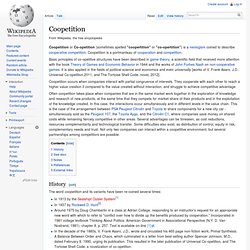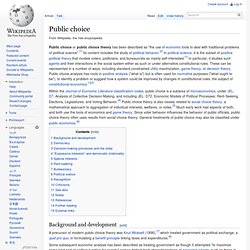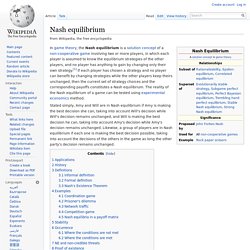

Reciprocal altruism. Diagram showing reciprocal altruism In evolutionary biology, reciprocal altruism is a behaviour whereby an organism acts in a manner that temporarily reduces its fitness while increasing another organism's fitness, with the expectation that the other organism will act in a similar manner at a later time.

The concept was initially developed by Robert Trivers to explain the evolution of cooperation as instances of mutually altruistic acts. The concept is close to the strategy of "tit for tat" used in game theory. Theory[edit] The concept of "reciprocal altruism", as introduced by Trivers, suggests that altruism, defined as an act of helping someone else although incurring some cost for this act, could have evolved since it might be beneficial to incur this cost if there is a chance of being in a reverse situation where the person whom I helped before may perform an altruistic act towards me.[1] There are two additional conditions necessary "…for reciprocal altruism to evolve:"[2]
Tragedy of the commons. The tragedy of the commons concept is often cited in connection with sustainable development, meshing economic growth and environmental protection, as well as in the debate over global warming.

It has also been used in analyzing behavior in the fields of economics, evolutionary psychology, anthropology, game theory, politics, taxation, and sociology. However the concept, as originally developed, has also received criticism for not taking into account the many other factors operating to enforce or agree on regulation in this scenario. Lloyd's pamphlet[edit] In 1833, the English economist William Forster Lloyd published a pamphlet which included an example of herders sharing a common parcel of land on which they are each entitled to let their cows graze.
In English villages, shepherds had sometimes grazed their sheep in common areas, and sheep ate grass more severely than cows. Garrett Hardin's article[edit] Social trap. Social trap is a term used by psychologists to describe a situation in which a group of people act to obtain short-term individual gains, which in the long run leads to a loss for the group as a whole.

Examples of social traps include overfishing, energy "brownout" and "blackout" power outages during periods of extreme temperatures, the overgrazing of cattle on the Sahelian Desert, and the destruction of the rainforest by logging interests and agriculture. [citation needed] Origin of the concept[edit] The application of behavioral psychology terms to behaviors in the tragedy of the commons led to the realization that the same short-term/long-term cause-effect relationship also applied to other human traps, in addition to the exploitation of commonly held resources. Platt et al. also introduced the terms social fence and individual trap. Group dynamics. Coopetition. Coopetition or Co-opetition (sometimes spelled "coopertition" or "co-opertition") is a neologism coined to describe cooperative competition.

Coopetition is a portmanteau of cooperation and competition. Basic principles of co-opetitive structures have been described in game theory, a scientific field that received more attention with the book Theory of Games and Economic Behavior in 1944 and the works of John Forbes Nash on non-cooperative games. It is also applied in the fields of political science and economics and even universally [works of V. Frank Asaro, J.D.: Universal Co-opetition,2011, and The Tortoise Shell Code, novel, 2012]. Coopetition occurs when companies interact with partial congruence of interests. Often coopetition takes place when companies that are in the same market work together in the exploration of knowledge and research of new products, at the same time that they compete for market-share of their products and in the exploitation of the knowledge created.
Public choice. Within the Journal of Economic Literature classification codes, public choice is a subarea of microeconomics, under JEL: D7, Analysis of Collective Decision-Making, and including JEL: D72, Economic Models of Political Processes: Rent-Seeking, Elections, Legislatures, and Voting Behavior.[4] Public choice theory is also closely related to social choice theory, a mathematical approach to aggregation of individual interests, welfares, or votes.[5] Much early work had aspects of both, and both use the tools of economics and game theory.

Since voter behavior influences the behavior of public officials, public choice theory often uses results from social choice theory. Prisoner's dilemma. The prisoners' dilemma is a canonical example of a game analyzed in game theory that shows why two individuals might not cooperate, even if it appears that it is in their best interests to do so. It was originally framed by Merrill Flood and Melvin Dresher working at RAND in 1950. Albert W. Tucker formalized the game with prison sentence rewards and gave it the name "prisoner's dilemma" (Poundstone, 1992), presenting it as follows: Two members of a criminal gang are arrested and imprisoned. Each prisoner is in solitary confinement with no means of speaking to or exchanging messages with the other. It's implied that the prisoners will have no opportunity to reward or punish their partner other than the prison sentences they get, and that their decision won't affect their reputation in future.
The prisoner's dilemma game can be used as a model for many real world situations involving cooperative behaviour. Strategy for the classic prisoners' dilemma[edit] The normal game is shown below: Win-win game. A win-win game is a game which is designed in a way that all participants can profit from it in one way or the other.

In conflict resolution, a win-win strategy is a conflict resolution process that aims to accommodate all disputants.[1][2][3] Types[edit] In colloquial speech, a win-win situation often refers to situation where one benefits, not necessarily through someone else's loss.In the context of group-dynamic games, win-win games are also called "cooperative games", "new games" or "games without losers".Mathematical game theory also refers to win-win games as non-zero-sum games (although they may include situations where either or both players lose as well).The TKI Thomas/Kilmann Conflict Profile provides a model that reveals preferences under stress and pressure.
Collaboration style focuses on win-win outcomes. Group dynamics[edit] Optimal distinctiveness theory. Optimal distinctiveness is a social psychological theory seeking to understand ingroup–outgroup differences.

It asserts that individuals desire to attain an optimal balance of inclusion and distinctiveness within and between social groups and situations (Brewer, 2003). These two motives are in constant opposition with each other; when there is too much of one motive, the other must increase in order to counterbalance it and vice versa (Brewer, 1991). The theory of optimal distinctiveness was first proposed by Dr. Marilynn B. Brewer in 1991 and extensively reviewed in 2010 by Drs. Nash equilibrium. In game theory, the Nash equilibrium is a solution concept of a non-cooperative game involving two or more players, in which each player is assumed to know the equilibrium strategies of the other players, and no player has anything to gain by changing only their own strategy.[1] If each player has chosen a strategy and no player can benefit by changing strategies while the other players keep theirs unchanged, then the current set of strategy choices and the corresponding payoffs constitutes a Nash equilibrium.

The reality of the Nash equilibrium of a game can be tested using experimental economics method. Stated simply, Amy and Will are in Nash equilibrium if Amy is making the best decision she can, taking into account Will's decision while Will's decision remains unchanged, and Will is making the best decision he can, taking into account Amy's decision while Amy's decision remains unchanged.
Game Theory.